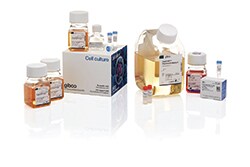Search
Advancements in Cell Biology

A not-so-rare discipline empowering frontline research. Whether they’re in disease modeling or vaccine production, innovations in cell biology and protein expression are foundational to driving everyday success.
Preparing for future viral epidemics
Vaccines are our first line of defense against infectious disease; however, their development requires years or even decades of research and clinical trials before being released for human use. This timeline means that we have no vaccine safeguard against future epidemics that could arise from the emergence of currently unknown agents, referred to by the World Health Organization (WHO) as “Disease X.”

The University of Queensland
A team of researchers led by Dr. Keith Chappell and Professor Paul Young at the University of Queensland (UQ), Australia, with funding from Coalition for Epidemic Preparedness Innovations (CEPI), is working to establish a vaccine pipeline that can deliver vaccines to affected communities within a timeframe that can halt the spread of an emerging epidemic. The team’s rapid response pipeline aims to produce a new vaccine, demonstrate its safety and indicators of efficacy, and manufacture more than 200,000 doses for potential field deployment. Triggering the pipeline only requires the sequence of the virus genome, something that can now be determined swiftly in the field from a patient sample. Viral surface proteins can then be synthesized in the laboratory, with UQ’s molecular clamp technology ensuring the recombinant protein produced will fold into a structure that reliably mimics the active form of the same protein that’s present on the virus’s surface.
To facilitate the rapid production of their vaccine candidates, the UQ team has chosen the Gibco ExpiCHO Expression System. The ExpiCHO system is uniquely suited to this project since the same cGMP-banked ExpiCHO-S Cells can be used for the entire manufacturing process: from early preclinical work using transient expression, to full-scale manufacturing employing a clonally selected, high expression–stable cell line. UQ is proud to be working to implement and validate this rapid-response vaccine pipeline, which they hope will be an important component of the global response against future viral epidemics.
Advance your own biologics development

Start in CHO, stay in CHO with cGMP- banked Gibco ExpiCHO-S Cells.
- Fully documented, cGMP- and regulatory-compliant cell lines
- Flexible commercial licensing without royalty obligations
- Derived from the same master seed bank as research-grade and widely used ExpiCHO-S cells
- Maintain high productivity from research to bioproduction using the same cell line
GIBCO Cell Culture Hero: Alexandra Taraboletti, PhD

Lombardi Comprehensive Cancer Center
Georgetown University
Our featured Cell Culture Hero uses cell culture models to examine the in vitro effects of radiation and to attempt to counter its negative impact on the brain.
Dr. Alexandra Taraboletti is a postdoctoral fellow in the Tumor Biology program at Georgetown University’s Lombardi Comprehensive Cancer Center, funded through a T32 Ruth L. Kirschstein National Research Service Award. Dr. Taraboletti received her PhD in chemistry from the University of Akron, where she used mass spectrometry–based metabolomics to investigate model neurodegeneration in multiple sclerosis and myelin biology.
In Dr. Fornace’s lab at Georgetown, Taraboletti applies metabolomics to assess biomarkers in easily accessible fluids following radiation injury. Specifically, she has worked on a new technology development for metabolomic-based biodosimetry, and she is exploring protection methods
to counter the negative impact of radiation in the brain. She uses a cell culture model of the myelin-producing oligodendrocyte cell to examine the effects of radiation in vitro. She is currently testing the use of dimethyl fumarate as a neuroprotectant against radiation injury.
In her other activities, Dr. Taraboletti is a co-chair for the Georgetown Postdoc Association—an establishment that acts to foster camaraderie and organize career development activities specifically geared toward postdocs. Her work has led to developing a workshop series that will foster teaching/higher education skills in interested graduate students and postdoctoral fellows. Dr. Taraboletti also has a passion for visual science communication, and she applies her skills as the graphical editor and illustrator for the association’s newsletter, The POSTDOCket. She is an avid artist, and is always looking to grow in the bourgeoning field of #sciart.
Interested in Gibco Cell Culture Heroes? Check out more here.
仅供科研使用,不可用于诊断目的。